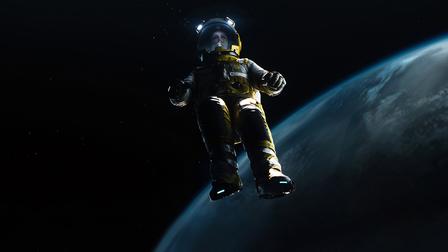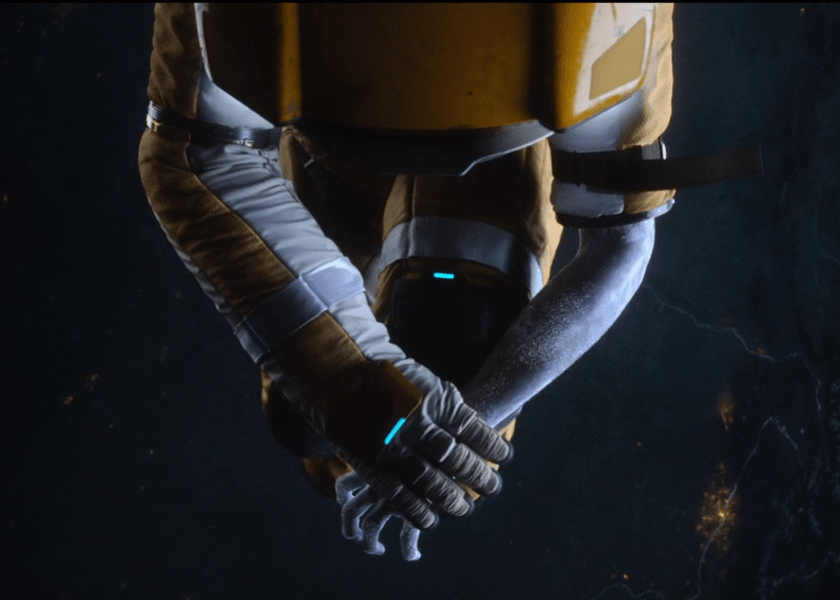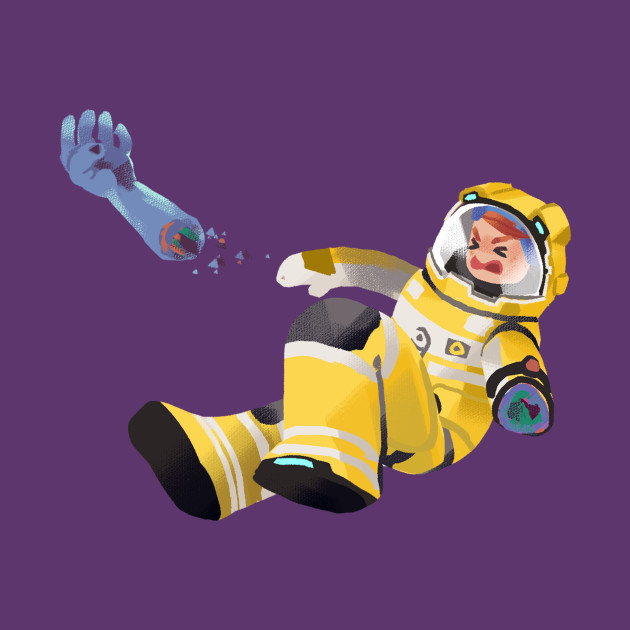Coming up, in no particular order: a gruesome story about space, a spoiler for the “Helping Hand” episode of Netflix’s series, Love, Death & Robots, and an explanation of how the conservation of momentum works. If you feel that any of those three topics will upset or offend, you may want to bail out now. No harm, no foul.
Let’s start with the spoilers…
In “Helping Hand,” Alex, the pilot of the Anthem maintenance craft finds herself working maintenance on a satellite – solo. Budgetary reasons are mentioned for Alex’s one-woman extra-vehicular activity (EVA), and the Anthem itself seems to be a little on the “could use some updates” side of things. This repair job is a cutting corners kind of thing.
Alex suits up and heads outside and does her work, unaware that a lost screw – space debris – is on an intercept path with her. The screw hits her oxygen tank and mobility unit and its backup, ruining the latter and starting a major leak in her air. As a result, Alex is drifting away from both the satellite and the ship. The good news – rescue teams will be to her in 58 minutes. The bad news – she’s only got a little over fourteen minutes of oxygen left before her tanks are empty.
For about twelve of those minutes, Alex is resigned to her fate and seems to go through the stages of grief. But when she’s down to two minutes of oxygen left, Alex survival instinct kicks into overdrive and she chooses a desperate path. Using her watch as a tourniquet/seal on her upper arm, she removes the portion of her suit that covered her left forearm and, when her position is right, throws it in the direction opposite the satellite and the Anthem. This gives her a bit of velocity back towards the two objects – but as she learns, her aim was off, and she’s just inches away on her left – where her dead arm cannot reach out for any hold.
Now, as her suit reports that she is completely out of oxygen, Alex makes one, final desperate bid – using her knee as leverage, she breaks her left arm off at the elbow and repeats her plan. Her tumbling return is harrowing, and the next time we see Alex, she’s making a call to her rescuers – although she’s missing an arm.
Before we talk science here, I should also mention that the episode was directed by Jon Yeo, with animation by Axis Studios, based on a short story by Claudine Griggs which first appeared in Lightspeed Magazine (it’s a quick, fun read – and in it, you learn that Alex’s full name is Alexandria Stephens and that before she made her first throw, she offered a prayer to Isaac Newton).
In the episode (and Griggs’ story), it was clearly explained that this was a low-budget, penny-pinching affair, so I’m not worried about the lack of any safety apparatus that you would have hoped (and Alex would have appreciated) being there. No – there was no tether to either her spacecraft or satellite, there was no stabilizing system like SAFER on Alex’s suit (or at least it was destroyed in the accident), and there wasn’t any kind of hand-held emergency propulsion system.
Again – all easily explained by the budget of the parent company, which was mentioned.

Drifting away (c) Netflix
Screwed
Okay – about that screw…that’s a prime example of space debris that space-faring companies are worried about, both on the way up and while in orbit. Anything that’s in orbit is being pulled back towards earth due to gravity. But – to remain in orbit, any object – satellite, monkey in a can, dog in a can, screw, paint fleck – must have orbital velocity as well. To stay in orbit, you need a push up and a push to the side. A hard push that will keep you moving, even though you’re falling. The earth curves away, the object keeps falling, the earth curves away, the object keeps falling, and on and on.
The International Space Station is traveling at 7.66 km/second (about 17,100 mph), which means it circles the earth once every 90 minutes or so. That means that everything on the ISS is moving that fast, and if something falls off the ISS (or any other satellite), there’s nothing to really slow it down…and it’s moving that fast as well. Roughly speaking and without going into too much math, objects in lower orbits have larger orbital velocities, objects in higher orbits have slower orbital velocity.
That screw? It was a bullet, traveling at perhaps around 7 km/second, depending on the height of its orbit. Alex was lucky it didn’t go through her.
But let’s talk about what happened when Alex removed the piece of her suit covering her forearm. We’ve talked about people in space before – a couple of times, in fact. Over the decades, the depictions of humans in space without protection has gotten better, and what happened to Alex’s forearm was fairly realistic – to a point. The surface action, the pain, okay. The solid-ness of it when she was desperate after throwing her glove…?
All told from glove removal to arm break, her arm was exposed to space for about two minutes, maybe a little more. And it was in the sunlight – without any atmosphere to absorb the energy, sunlight alone can raise the temperature of an exposed surface to 250℃, and Alex’s arm was in full sunlight.
In addition, (and check the earlier linked articles for more details), your body heat doesn’t leave immediately when you go into space unprotected. You get cold in chilly water or a cool breeze because of convection and conduction. Your body heats up the air or water in contact with your skin, that warmer air or water moves away, and is replaced by cool air or water. Your body heats that air or water up, and the process keeps repeating. The result – you’ve spent a lot of heat to warm up a constantly changing environment.
In space, there’s no air to warm up and move away once it’s warmed. As a result, the only means by which you’ll lose heat is radiation – just sending heat out as infrared energy. It will get you cold – just not as quickly as conduction or convection.
There would be other issues at play involving pressure, but these would be largely minimized since she cinched down her watch strap to seal the rest of her suit, and she had no open wounds on her exposed arm that would have exposed her blood to the vacuum of space. Let’s not worry about those.
But still – the sunlight, losing heat through the relatively slow process of radiation, and the short time frame (around 2 minutes) that we’re looking at here…it’s very unlikely that Alex’s arm would have been frozen solid.

In space, no one recommends taking off a piece of your suit. This is why. (c)Netflix
Movement Without Propulsion in Space?
If you’re not up on your physics, sometimes the conservation of momentum can look like magic. Conceptually, momentum is a quality possessed by mass when it is in motion. Practically (and mathematically) it looks like this:
momentum = mass * velocity
Momentum’s units are a hankie-clutching mess: kg*m/s. What applies about momentum here is that in collisions, momentum is always conserved. More formally stated, in a collision between two objects in an isolated system, the total momentum of the objects before the collision is equal to the total momentum of the objects after the collision. Any momentum lost by one object is gained by the other object.
Two objects, cars, for example, traveling toward one another, have a certain amount of momentum. If they collide, the system (the two cars) must have the same amount of momentum. Always remember, velocity is a vector, so it has a + or – sign, depending on direction.
Look back at that formula for momentum – this is why, in a car crash where two cars are traveling towards one another with the same velocity, the small car (less mass) flies away while the large car (more mass) can shrug the whole thing off. Smaller mass, larger velocity. Larger mass, smaller velocity.
There are two types of collisions where momentum is conserved: elastic (as my students say, “hit and bounce”) and inelastic (“hit and hug” according to my students), and you can dig into them over at The Physics Classroom. We’re not worried about either of those with Alex – we’re looking at an explosive, or explosion type of system.
After the accident, Alex is drifting away from the satellite (velocity) and she has mass – therefore she has momentum. When she throws her glove, and later, her forearm, the end result has to be that the total amount of momentum remains the same.
Let’s look at some numbers:
Let’s assume Alex + her suit have a combined mass of 115 kg (60 kg for her, and 55 for the suit, using numbers similar to the EVA suits on the ISS), and she’s drifting (relative to the satellite) at a leisurely 0.25 m/s away from it, so I’ll indicate that direction as negative (as always, if you don’t dig my numbers, replace them with your own and run your own calculations). Therefore, her momentum is:
momentumAlex + suit = 115 kg * – 0.25 m/s
momentumAlex + suit = -28.8 kg*m/s
That’s out momentum budget. All we’ve got. Anything she does, this is all she has to work with.
A note on Alex’s velocity and that of the satellite – they must be moving in the same direction, that is when the accident pushed Alex off the satellite, she was pushed off in the same direction the satellite was moving. But – the problem is, with nothing to slow her down in space, she’ll continue to move 0.25 m/s away from the satellite. It would get smaller and smaller – slowly, compared to rapidly disappearing if it and Alex were moving in opposite directions.
A note on the scale and time here – watch the story and make your own measurements. It just doesn’t work. She drifts for about 14 minutes before making her drastic choice. Even at 0.25 m/s, she’s be 210 meters from the satellite (14*60*.25). Clearly, in the story – she’s not. Throughout it all, she’s within perhaps 200 meters of the satellite. So, there’s that.
But the time is the only thing that messes with the physics, really. Had Alex realized her situation and immediately (when she had 14 minutes of oxygen left) made her decision, the distances would’ve been manageable.
Let’s finally get to some conservation of momentum:
Alex’s momentum is -28.8 kg*m/s. That means that when she throws the glove (away from the satellite), the sum of her momentum plus the glove’s momentum must add up to -28.8 kg*m/s.
In other words:
momentumtumblingAlex = momentumglove + momentumAlex-glove
Or
(masstumblingAlex)(velocitytumblingAlex) = (massglove)(velocityglove) + (massglovelessAlex)(velocityglovelessAlex)
For Alex’s first attempt at sending herself backward, let’s assume that her glove has a mass of 3 kg, and she makes a really good throw away from the satellite – about -22 m/s (roughly 50 mph). How fast is she going back towards the satellite?
With numbers, then:
-28.8 m/s = (3kg)(-22m/s) + (112kg)(vglovelessAlex)
solving…
vglovelessAlex = .33 m/s
Notice – if we’re careful and make sure to use a value of -22 m/s for the glove’s velocity, the calculation gives us a positive value for gloveless Alex’s velocity, which means she’s headed back towards the satellite.
What very nearly kills Alex is the fact that velocity is a vector. That means, it has both a magnitude (the number) and a direction. When she threw the glove away, she needed to be very careful to make sure she was aligned in just the right spot so that her velocity would take her back towards the satellite. She had to aim.
Confounding that was the fact that she couldn’t use both hands to push it directly away from her at a point over her center of mass (her left arm was useless). As a result, she did a one arm throw, her rotational force was unbalanced so she had a bit of a spin and was off target by just a few, agonizing centimeters.
The only tricks to this are: remembering that you have the momentum of gloveless Alex from above, which would apply to her while her arm is attached and when she’s broken it off and is holding on to it, and also remembering to subtract her arm’s weight from armless Alex’s momentum. A little less mass there will mean she’ll have a tick more velocity.
Let’s assume Alex’s forearm has a mass of about 3% of her body mass, so about 1.8 kg.
Same formula, same run through, different numbers.
momentumglovelessAlex = 112kg * .33m/s
momentumglovelessAlex = 37 kg*m/s
So…
(massglovelessAlex)(velocityglovelessAlex) = (massarm)(velocityarm) + (massarmlessAlex)(velocityarmlessAlex)
One last thing – and I swear we’re almost done – remember your directions here. With the glove throw, Alex changed her direction and was moving in what we’ve called the positive direction. She went past the satellite, so to get to make this work, she’s going to have to throw the glove in the positive direction, which will make her move in the negative direction. As I tell my students – if you forget the signs, you’re going to have a bad time – and not know what’s going on. So – Alex’s throw of her arm would send her back towards the satellite. Let’s work the problem.

Like everything, something on the internet is turned into a cartoon image for a t-shirt (c)Netflix
And let’s assume Alex throws her arm with the same velocity as the glove…I figure she’s tired, but the arm has less mass than the glove. And remember to subtract the mass of Alex’s arm from Alex.
37 kg*m/s = (1.8kg)(22m/s) + (110.2kg)(varmlessAlex)
Do the math, and you see the problem.
varmlessAlex = -0.02 m/s
So even Alex threw her arm at 50 mph (22 m/s), she’s only getting a velocity of about 2 centimeters per second back towards her ship.
But she does make it – we see that much in the story. But making it before she completely ran out of oxygen – that would have been a stretch. One other thing – before the arm throw, Alex is moving parallel to her ship’s location. She throws it in a direction that’s perpendicular to her motion and starts a tumble in the opposite direction to her throw. Vectors don’t work that way – you can’t make a 90° as a result of those two velocities. She would’ve traveled at a vector sum of her parallel velocity and the velocity she had after the arm throw, and traveled some diagonal path towards the ship – again opening up the possibility she’s going to miss it.
Ultimately – the physics kind of stand up (mass is a problem as we’ve seen), but the timing. Physics protip – if you’re ever in a situation like Alex – do not wait. Rip that glove off in a hurry and make your throw. While the story clearly worked for drama – feeling sorry for yourself for a whole twelve or fourteen minutes – that’s what would’ve killed you. At the masses and velocities she had available, there was no way Alex could’ve made up the ground she would have needed to in the time she had.
How Would I Use This is a STEM Classroom?
Okay – I tried to keep the critique down to a minimum because overall, this was a pretty sweet example of the conservation of momentum – something intro physics students can have a tough time with. It wasn’t perfect, but it made a solid attempt to get the physics in there, which is something of a rarity when it comes to characters in space.
Would I use this short? Erm…no. Not if I work in a public school and want to keep my job, or at least not get called into the administrator’s office to defend my choice of media. It’s got swears in it. More than a couple. You lose some of the impact when you mute it, and while changing the dialogue language may sound helpful, it just teaches your students swear words in a foreign language. I may or may not know that from experience.
But – it’s a great idea for a summative activity for momentum. Pending Netflix releasing a censored or bleeped version for educational purposes (hey Netflix, how about it? Netflix Education? Netflix for Schools?) I would recommend that you do not reinvent the wheel, or open yourself up to copyright issues, and just send your students to Claudine Griggs’ original story in Lightspeed Magazine. After reading it, ask them to critique the story from a physics point of view – not to be overly critical of it on the surface, but asking them, “could this happen as explained in the story?” and have them defend their responses with sample calculations and other explanations. Guiding their thinking with questions would be ideal.
And the extensions – where can they take what they learned with this? Conservation of momentum (along with implications of Newton’s Third Law) are huge concerns in space where there’s no friction to slow you down or stop you. Where would something like this be a problem in real life? Has it been a problem on space missions? How could you model this on earth? And if I was doing this in my class, I’d take Rhett Allain’s tip and have them either present their findings on video or solve the guided questions individually, on video.
For a real challenge – don’t have them read the story at first…assume Alex missed on her arm throw, and her body is found later. Give the students all they need, but have them work the problem backwards, and figure out what Alex did. Then have them read the story.
The implications and extensions go on and on.







